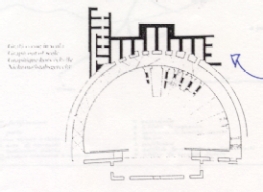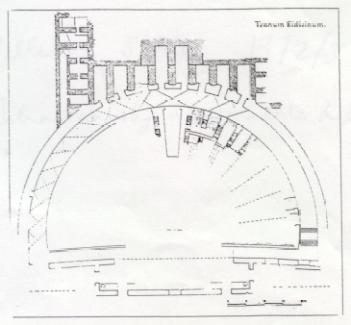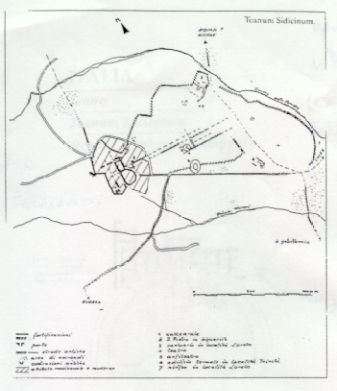Teano
Teano (Teanum Sidicinum)
Date of Visit: 8 Nov 1999
Archaeologist: Francesco Sirano
Karina's Documentation [DOC]
Theatre temple, stage of rectilinear form, i.e. similar
to the one in the Theatre of Pompey in Rome from 55 B.C.
(early phase).

Plan of theatre from Teatri Greci e Romani

Plan of theatre (source unknown)
Buildings to east of cavea on private grounds; hidden
now (possibly destroyed?). Latest information on these
is Johannowsky. (Bulletino d'Arte 1972/3; Johannowsky:
later article and diagram.)
Dimensions
Skene: 24 m high.
Cavea: 85 m wide
Phases
1. 2nd Century B.C.: opus incertum in sub-structure
of cavea

2. Augustan rebuild: opus reticolatum and
quasi-reticolatum

3. 3rd century A.D.(Severan)
Columns now in church in Teano town (the church with cisterns
below).
Severan Brickwork.
Inscription.
Colossal statue (near porta regia?)
Extensive foundations post-scaenam, but in process
of being excavated, so no reliable dates / interpretations
possible yet.
Cavea
85 m wide.

Cross-section
5 stair-ways (klimakes)
6 kerkides
fragments of prohedria.

Original stairs exist: steps are brick reconstructions.
Severan balteus (tribunalium?)

Counter-radial ambulatorium under rear wall of cavea,
including latrines.

Scaenae frons
One-third of scaenae frons is excavated.
24m high.

Marble very varied.

All sculptural decoration (capitals etc.) are Severan.
Very rich, large-scale and excellent quality. Pentelic
marble is used for most of the grand-scale and detailed
work.
Two orders, including composite. Granite (red and
grey); Africano?; Alabaster
Unexcavated 'Fecit' at stage area
In fossa, 'post-holes' (marble)

For space between pulpitum façade and scaenae
frons, see photos.
Deep rectilinear and semi-circular niches in pulpitum
façade.
Visible rostra-like supports for wooden staging.
Regularly-spaced column-bases (Pentalic-like) every c. 1½
meters.
Extensive post-scaenam foundations, but in process of being
excavated, so no reliable dates / interpretations possible
yet.
Parodos / Orchestra
Strange marble rim:

Significance of Teano to TPP
Part free-standing
Some structure behind cavea; possibly a temple. (cf.
Palestrina: possible foundations for terrace-system for
a temple)
Counter-radial ambulatorium under rear wall of cavea.

Plan showing site of theatre (source?)
Notes from Teatri Greci e Romani.
ITALY
Teano
Teanum Sidicinum
Regio I, Latinum and Campania
A. Ianiro.
Graeco-roman theatre in the first phase, Roman in the
second. Urban, linked to a temple built at the rear
facing the same way. Facing east.
Built in the late 2nd and early 1st century B.C., it
was restructured in the 2nd century A.D.
The more than semicircular cavea rests on a slope, which
is contained and made regular by substructure walls.
These walls form twenty-three barrel vaults built close
to the terrace temple situated in the upper part.
When the theatre was reconstructed in the 2nd century,
a new outer ambulatory was added. The cavea is divided
into two maeniana, which are split radially into
six cunei. The radial ambulatories and rooms interlinked
by large arches provided access to each area of steps.
The horseshoe-shaped orchesta could be reached from the
rectilinear parodoi. The large scaena
was rectilinear. It had two orders with at least
three doors and was preceded by a pulpitum.
The parodoi featured arched passageways facing
the rooms at the sides of the scaena.
The structure is built in opus incertum.
The most ancient parts are in opus quasi reticulatum
in grey tufa. The restructured parts are in opus
latericium. The decoration was marble.
State of preservation
the visible structures are preserved to a considerable
height, but only account for a third of the monument.
Measurements:
diameter of the cavea: 85 m.
height of the scaena: 24 m.
Bibliography
W. Johannowsky, Relazione preliminare afli scavi di
Teano, in BA 1963, p.131 ff.
H. Lauter Die hellenisstischen Theater der Samniten
und Latiner in ihere Beziehung sur Theaterarchitektur
der Griechen in Hellenismus in Mittelitalien
Göttingen 1974, p.413 ff.
F. Perego (ed) Memorabilia: Il futuro della memoria
Roma 1987, p.437 ff.
K. Mitens 1988 p.172 ff.
B. Courtois 1989, p.231 ff.
C. A. Ianiro, Lunga storia di Teano, in "Archeo"
1990, num. 63, p. 124 ff.
TO DO
Write to Johannowsky and ask reasoning for thinking
it's a temple.
